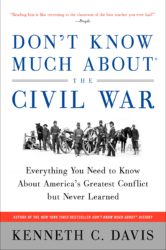(Originally posted on July 13, 2010; reposted July 11, 2022)
On July 11, 1863, the first Civil War draft lottery took place in New York City.
On July 13, 1863, New York City exploded in a four-day long murderous riot, still considered one of the deadliest urban riots in American history. The cause of the riots–violent opposition to the Civil War draft law.
Since poverty has been our crime,
We bow to the decree.
We are the poor who have no wealth
To purchase liberty.
If your picture of draft dodgers is one of 60s-era hippies shouting “Hell No, We won’t go,” the ditty above offers another vision.
It comes from the Civil War era, when the United States passed its first federal draft, the Enrollment Act, in March 1863. (A Confederate Draft had actually preceded the federal draft by two years.)
Under the rules of the law, there were certain exemptions –telegraph operators and railroad engineers were excused, as were certain government employees.
Then there were the rich. They were different. Under the terms of the Civil War draft, a man could avoid the draft by paying $300 or hiring a substitute. J.P. Morgan, Andrew Carnegie, and future President Grover Cleveland all did it. So did the wealthy father of Teddy Roosevelt.
The practice led to the complaint that the Civil War was “A rich man’s war, but a poor man’s fight.”
Coming on the heels of the Emancipation Proclamation announced in January 1863, the draft law was bitterly resented. By the summer of 1863 angry protests had taken place in nearly every union state. The headline of one Pennsylvania newspaper read: “WILLING TO FIGHT FOR UNCLE SAM BUT NOT FOR UNCLE SAMBO.”
And resistance to the draft soon turned ugly. Nowhere was the opposition greater or more violent than in New York City where Lincoln was despised by the powerful Democratic party which was openly critical of his administration. The working class Irish were particularly resentful of policies that allowed the wealthy to buy their way out of the draft, and they were hostile toward blacks, many of whom had been used to replace striking Irish longshoreman at New York’s docks.
The anger spilled over into violence in July 1863. On Saturday morning, July 11, the first draftees’ names were pulled in a lottery and announced. They were published alongside the casualty lists from the recent battle of Gettysburg, fought from July 1-3, 1863.
The following Monday, July 13, the draft office at Third Avenue and Forty-sixth Street was attacked by a mob of men armed with clubs who set the building afire. The fire brigade, angry that their jobs were not entitled to an official exemption, joined the mob instead of putting out the fire.
This was the beginning of a four-day spree of looting and arson that ended with murderous rioting.
Singled out for deadly attacks was the city’s black population. The rioters, many of them too young for the draft got caught up in the frenzy. Hundreds of mostly Irish rioters burned and pillaged their way down Third Avenue, en route to an armory where they seized hundreds of rifles. Another mob attacked an orphanage where black children lived. The anger boiled over into grotesquely savage atrocities. A crippled black coachman was lynched and his body burned. After his genitals were cut off, the mob dragged the body through the streets
One newspaper account published by the African Methodist Episcopal church, read:
“Many men were killed and thrown into the rivers, a great number were hung to trees and lamp-posts, numbers shot down; no black person could show their heads but that they were hunted like wolves. These scenes continued for four days.”
The riots left at least hundreds dead –some estimates range to two thousand—of course, most of them black. Order was eventually restored when troops arrived, some of them from West Point, others returning to New York from the Gettysburg battlefield.
Read more about the Draft Riots in DON’T KNOW MUCH ABOUT THE CIVIL WAR
